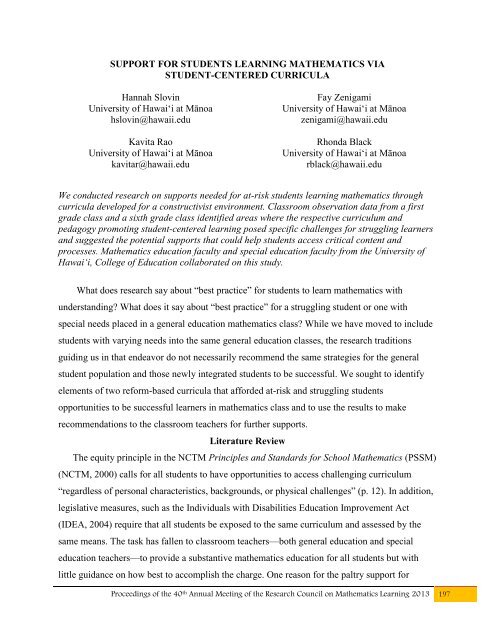2013 Conference Proceedings - University of Nevada, Las Vegas
2013 Conference Proceedings - University of Nevada, Las Vegas
2013 Conference Proceedings - University of Nevada, Las Vegas
- No tags were found...
Create successful ePaper yourself
Turn your PDF publications into a flip-book with our unique Google optimized e-Paper software.
SUPPORT FOR STUDENTS LEARNING MATHEMATICS VIASTUDENT-CENTERED CURRICULAHannah Slovin<strong>University</strong> <strong>of</strong> Hawai‘i at Mānoahslovin@hawaii.eduKavita Rao<strong>University</strong> <strong>of</strong> Hawai‘i at Mānoakavitar@hawaii.eduFay Zenigami<strong>University</strong> <strong>of</strong> Hawai‘i at Mānoazenigami@hawaii.eduRhonda Black<strong>University</strong> <strong>of</strong> Hawai‘i at Mānoarblack@hawaii.eduWe conducted research on supports needed for at-risk students learning mathematics throughcurricula developed for a constructivist environment. Classroom observation data from a firstgrade class and a sixth grade class identified areas where the respective curriculum andpedagogy promoting student-centered learning posed specific challenges for struggling learnersand suggested the potential supports that could help students access critical content andprocesses. Mathematics education faculty and special education faculty from the <strong>University</strong> <strong>of</strong>Hawai‘i, College <strong>of</strong> Education collaborated on this study.What does research say about “best practice” for students to learn mathematics withunderstanding? What does it say about “best practice” for a struggling student or one withspecial needs placed in a general education mathematics class? While we have moved to includestudents with varying needs into the same general education classes, the research traditionsguiding us in that endeavor do not necessarily recommend the same strategies for the generalstudent population and those newly integrated students to be successful. We sought to identifyelements <strong>of</strong> two reform-based curricula that afforded at-risk and struggling studentsopportunities to be successful learners in mathematics class and to use the results to makerecommendations to the classroom teachers for further supports.Literature ReviewThe equity principle in the NCTM Principles and Standards for School Mathematics (PSSM)(NCTM, 2000) calls for all students to have opportunities to access challenging curriculum“regardless <strong>of</strong> personal characteristics, backgrounds, or physical challenges” (p. 12). In addition,legislative measures, such as the Individuals with Disabilities Education Improvement Act(IDEA, 2004) require that all students be exposed to the same curriculum and assessed by thesame means. The task has fallen to classroom teachers—both general education and specialeducation teachers—to provide a substantive mathematics education for all students but withlittle guidance on how best to accomplish the charge. One reason for the paltry support for<strong>Proceedings</strong> <strong>of</strong> the 40 th Annual Meeting <strong>of</strong> the Research Council on Mathematics Learning <strong>2013</strong> 197




